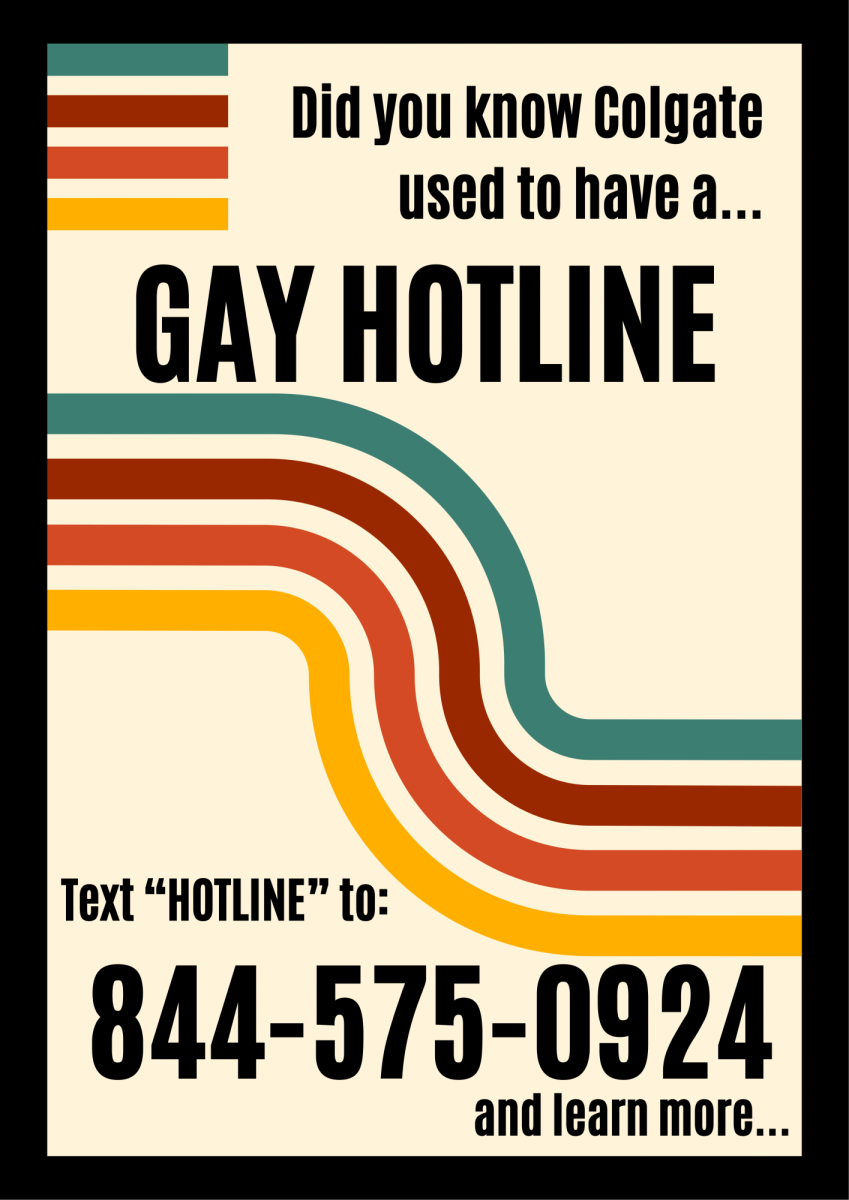Tasked with creating a piece of public art, a group of Colgate University students completed archival research into Colgate’s Gay Hotline and set up a new hotline to provide information and human accounts about its history. The group also worked on recreating advertisements, such as those that used to appear in the Maroon-News.
First-year Helen Reichert, sophomore Lauren Widdowson, juniors Bennett Rowe and Ellie Kelk and senior Haley Bloch worked on the project, with students coming from art history courses taught by Professor of Art DeWitt Godfrey and Visiting Assistant Professor of Art Rachel Boate. Boate’s ARTH 247 students aimed to research an aspect of Colgate’s history, and Godfrey’s ARTS 131 students hoped to create designs to commemorate that history.
Having disappeared from use, Colgate’s Gay Hotline was active on campus around the ’70s and ’80s. Advertisements for the hotline frequently appeared in the Maroon-News. In addition to recreating advertisements for the hotline, the students also recreated other advertisements that would have been featured in the Maroon-News at the same time.
Reichert, a student in ARTS 131, addressed how stumbling upon the history of the hotline is not easy.
“It’s a part of our history that’s not really talked about at all,” Reichert said. “I had no idea it existed. I’ve talked to alumni, and they didn’t really remember it or knew it existed.”
Boate also commented on the little awareness of the hotline, sharing how she herself did not know of its existence.
“This is only my second year teaching at Colgate, so I was completely unaware that the queer community established a Gay Hotline here at Colgate,” Boate said. “I knew that these types of underground networks and clandestine meetings existed at universities throughout the 1970s and ’80s, but it was the archival research conducted by Rowe, Bloch and Kelk that made me aware of this history here at Colgate.”
In addition to the difficulty of accessing information on the hotline, Reichert noted that students are not going out of their ways to seek out knowledge on its history.
“There’s a lot of information about the Hotline, but it’s not easily accessible, and it’s not something that students are actively trying to find,” Reichert said.
Rowe, a student in ARTH 247, also commented on the limited access to and awareness of this history. Having researched it, Rowe looked into archival interviews from the Maroon-News. He acknowledged doing such extensive research is one of the only ways to come to know things about the hotline, so he believes that the ads will contribute to greater awareness on campus.
“You wouldn’t really know unless you dug into Colgate’s history, so I’m hoping that people will get to learn about the hotline,” Rowe said.
Rowe commented that he even originally considered how the project could reflect the mystery of the hotline.
“In my original proposal, I wanted it to be sightless because in the early queer community a lot of aspects were pretty hidden,” Rowe said.
Expounding on its elusiveness, Rowe spoke of the secretive meetings for callers and operators that Boate referenced.
“If you called the hotline, you had to meet with someone in person, [but] there was always the fear of being outed,” Rowe said.
On a practical level, the hotline in its original entity was an operated phone number that Colgate students could call. For the new version, the ads invite students to text “HOTLINE” to the number 844-575-0924. Reichert explained they made this change because they wanted to cater the form of the hotline to students now.
“We were set on the idea of the hotline, which is why we decided to go the more technological route by choosing text messages over calling. No one’s going to call a phone number — people are more likely to text,” Reichert said.
Reichert further explained how the group intended for the designs of the stickers and flyers — which are available throughout campus — to acknowledge the progress in history.
“For the stickers, what we wanted to do was to show the progression of queer activism by using different styles of phones. There’s different phones from different decades,” Reichert said.
In addition to the stickers and flyers for this project on queer activism, the projects from the four other groups created public art in other creative ways to recognize the past.
Their works include a newsstand outside the Colgate Memorial Chapel to commemorate student activism, two lockers at Whitnall Field to commemorate the dismantling of Colgate’s varsity baseball team, a monument along Willow Path to commemorate women’s history at Colgate and a piece at Taylor Lake to commemorate the history of student life there. These projects are a culmination of several facets of Colgate’s history, known and unknown.
Touching on advocacy, Rowe expressed awe for how resilient Colgate students were who participated in this history — whether they were calling or listening on the other end.
“I think that I’m always surprised by the resiliency of the people who operated the hotline and those who called the hotline because they faced a lot of discrimination,” Rowe said.
Although queer life on campus has changed since then, Reichert addressed how the recreation of the hotline is still relevant to Colgate culture today.
“I heard a lot of students who say although there’s a lot of safe spaces on campus, they’re just not as prevalent as they should be, so even though this is not a project that is necessarily working to create a group or another safe space, it is just showing that these students are active on campus,” Reichert said. “This is something that is a part of Colgate, and it’s something that’s part of Colgate’s history, and it will always be a part of Colgate.”
Encompassing the work of all of the projects, Boate believes that the pieces can help initiate thoughts and facilitate discussions for members of the Colgate community. These projects ultimately celebrate the visible experiences and shed light on the invisible ones.
“My hope is that engagement with all of these projects will encourage students, faculty, staff and the wider community to stop and at least briefly reflect on Colgate’s histories, rather than take its spaces and conventions for granted,” Boate said.
















